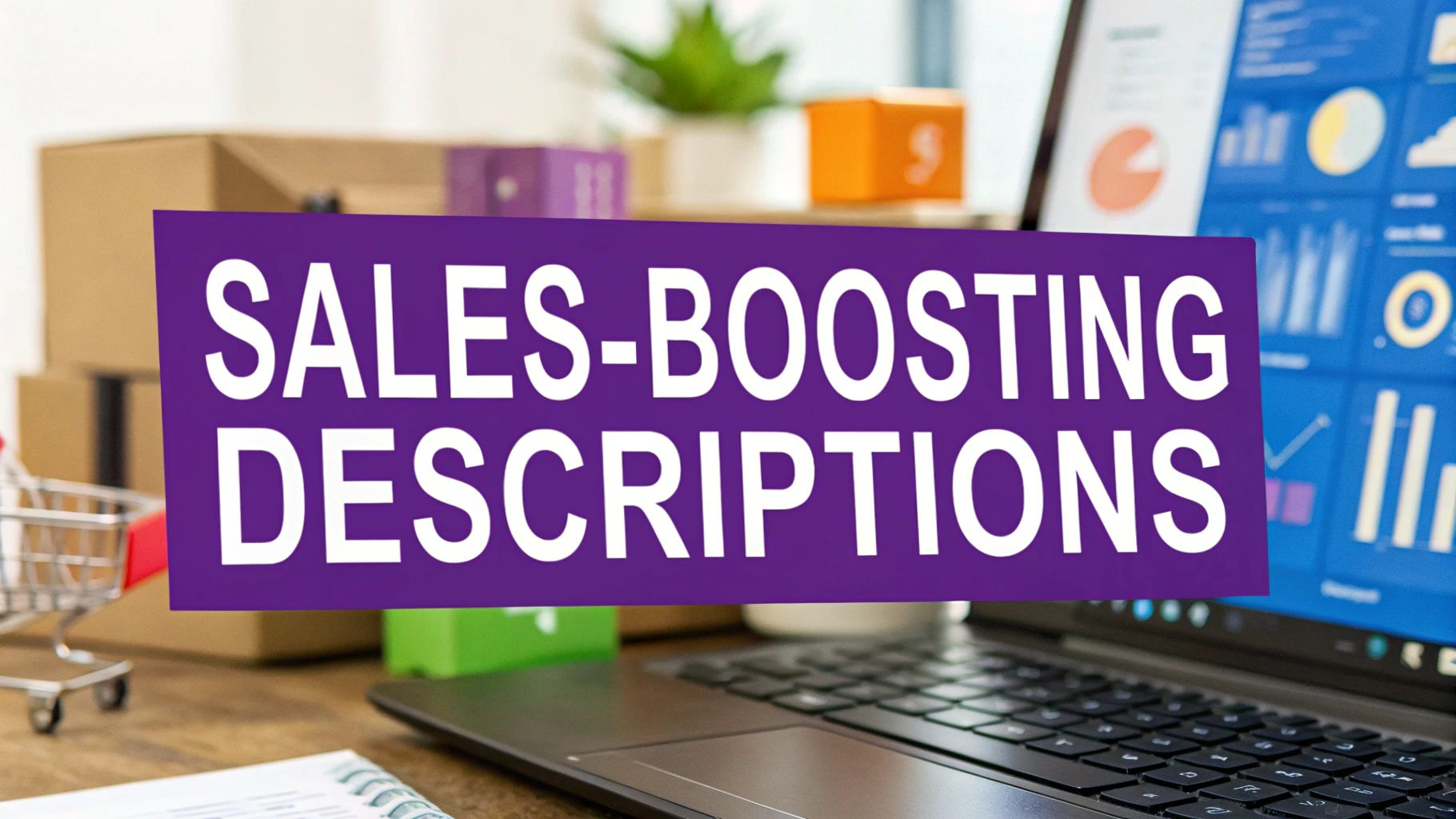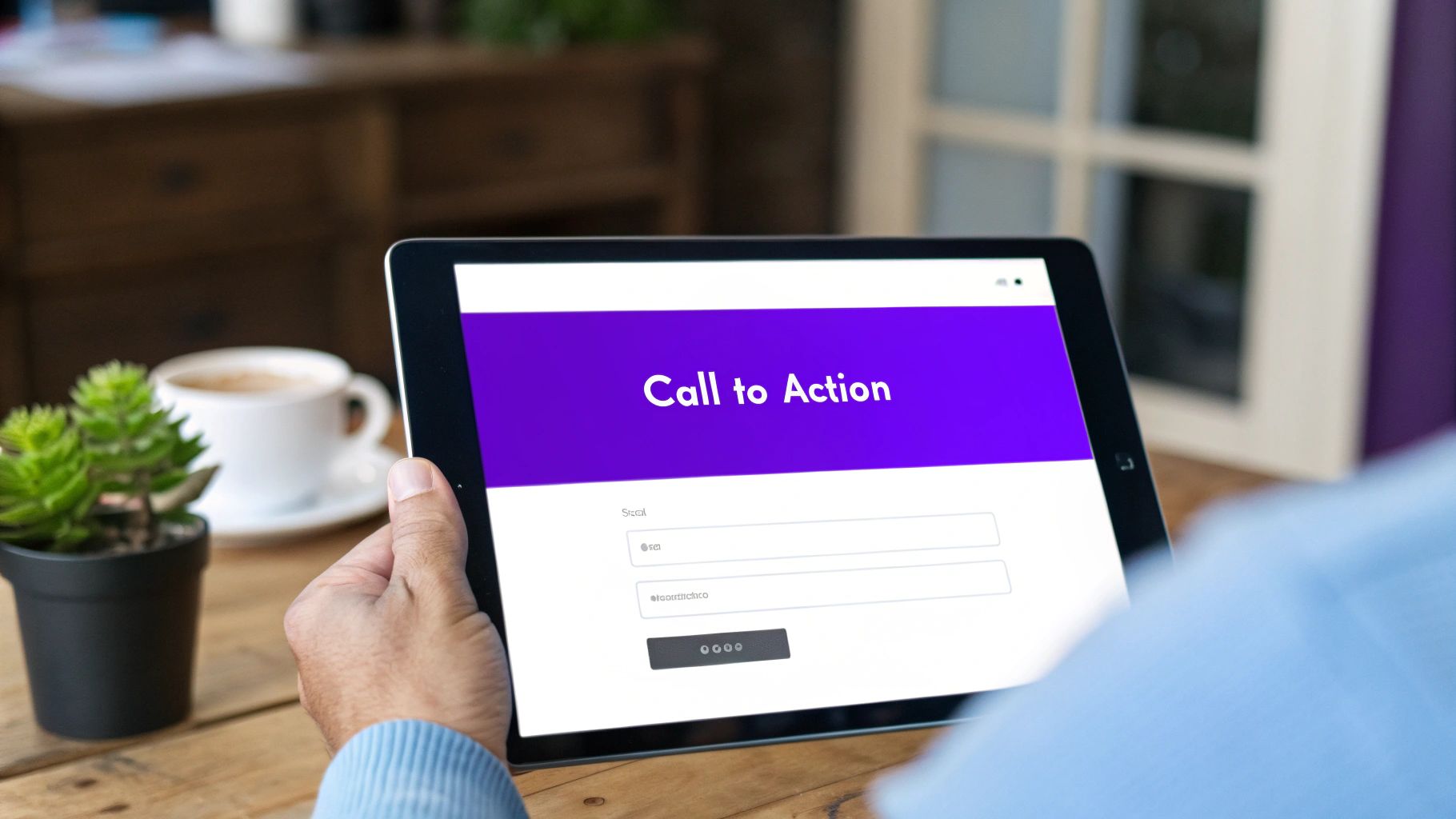How to Write Product Descriptions That Drive Sales: A Complete Guide

Understanding Your Target Audience

Creating product descriptions that really connect starts with knowing who you're writing for. It's not just about listing what your product does - it's about understanding what matters to your customers and speaking directly to their needs. Let's explore how successful online stores research their customers to write descriptions that feel like personal recommendations rather than sales pitches.
Building Buyer Personas
The first key step is creating Buyer Personas - detailed profiles of your ideal customers based on real data and market research. These profiles cover everything from basic demographics to deeper insights about shopping habits and what drives purchasing decisions. For instance, if you sell premium skincare products, your persona might be a 35-year-old professional woman who prioritizes natural ingredients and is willing to spend more for proven anti-aging benefits.
Adapting Your Voice
The way you speak to your customers matters just as much as what you say. A young, trendy clothing brand might use casual, fun language, while a luxury watch company would opt for a more sophisticated tone. Take Dr. Squatch, for example - they've mastered speaking to their male audience with phrases like "ultra-manly, woodsy scent" that perfectly match their brand personality. According to Shopify's research, using language that clicks with your specific audience significantly boosts engagement and sales.
Gathering Customer Language
One of the most effective ways to improve your descriptions is to use your customers' own words. Pay close attention to the language they use in reviews, social media comments, and customer service conversations. When you incorporate these authentic phrases into your product descriptions, you're speaking their language - making your message clearer and more convincing.
Identifying Emotional Triggers
Understanding what moves your customers to action is crucial. What are their hopes and fears? What problems keep them up at night? For example, when describing a fitness tracker, you might focus on the desire to live healthier or the worry about falling short of fitness goals. When you tap into these emotional drivers, you create stronger connections with customers and make your products more appealing.
Optimizing Descriptions for Search Engines

Writing great product descriptions isn't just about convincing customers - you also need to help search engines understand what you're selling. But this goes beyond just adding keywords. The real art is creating engaging copy that appeals to both humans and search engines at the same time.
Keyword Research for Product Pages
The foundation of good SEO starts with understanding what your customers are actually searching for. If you sell handmade candles, for example, your research might reveal that people frequently search for terms like "soy candles," "aromatherapy candles," or "gift candles." Tools like Google Keyword Planner, Ahrefs, and SEMrush can help you discover these valuable search terms.
Natural Keyword Integration
After identifying your key search terms, the next step is weaving them naturally into your descriptions. The key is to avoid keyword stuffing - nobody wants to read robotic text that's clearly written for search engines. Instead, focus on incorporating keywords in a way that sounds natural and adds value for your readers.
The Power of Structured Data
Structured data helps search engines better understand your products. Think of it as a special language that tells search engines exactly what your page is about - from product names and prices to availability and reviews. Using Schema.org markup can help search engines display your products more effectively in search results.
Optimizing Metadata and Image Alt Text
Don't forget about the behind-the-scenes elements that impact SEO. Your meta descriptions act like mini-advertisements in search results, while image alt text helps both search engines and visually impaired users understand your product images. Both elements give you more opportunities to thoughtfully include relevant keywords.
Recent data shows the impact of good SEO practices - ProductLed.com reports that well-optimized product descriptions can boost search rankings by up to 25%. And it's not just about the text - products with optimized descriptions and high-quality images from multiple angles saw a 20% increase in organic search traffic. By paying attention to all these elements, you create product pages that both search engines and shoppers love.
Crafting Compelling Features and Benefits
Strong product descriptions go far beyond basic specs and features. The key is turning those details into stories that connect with your customers by showing exactly how your product makes their lives better.
From Features to Benefits: The Key to Persuasion
At the heart of effective product writing is understanding two key elements: features explain what your product is or does, while benefits show how those features improve customers' lives. For instance, rather than just listing technical details, you want to explain their real value.
Let's look at Wand Websites as an example. Instead of simply stating it has a "drag-and-drop interface," they explain how this means "you can build a professional website without any coding skills, saving both time and money." See how the benefit focuses on what matters to the customer?
Identifying Your Product's Persuasive Selling Points
Some product features matter more than others to customers. To find your most compelling selling points, consider:
Target Audience Needs: What problems do your customers face? Which features solve those problems? For example, Etsy sellers making over $10,000 monthly need more control than Etsy provides - making customizable storefronts and direct customer communication essential features.
Unique Advantages: What sets you apart from competitors? Wand Websites offers fixed pricing, outcomes, and timelines - addressing common frustrations with website projects.
Emotional Drivers: What do customers dream of achieving? Wand Websites connects with Etsy sellers' desires for growth and independence by showing how their platform helps them expand beyond Etsy.
Presenting Benefits in a Compelling Way
Once you know your key benefits, present them in ways that resonate. Here's how:
Use Clear, Vivid Language: Rather than saying "easy to use," describe how "the simple interface lets you build your site with point-and-click ease."
Focus on Results: Instead of claiming "increased sales," share specifics like "double your revenue with a professional Shopify store." Wand Websites demonstrates this by highlighting successes like Minter & Richter's significant growth.
Provide Real Examples: Make benefits tangible. Don't just promise to "save time" - explain how customers can "launch their stunning new site in hours instead of weeks."
The art of turning features into benefits comes down to truly understanding how your product improves customers' lives, then communicating that value through clear, meaningful stories. When you master this approach, your product descriptions will naturally connect and convince.
Using Psychology in Product Descriptions

Getting customers to find your products through SEO is just the first step. The real art lies in convincing them to make a purchase. This is where understanding consumer psychology comes in - knowing what makes people click "buy" and crafting descriptions that speak to those motivations.
The Power of Social Proof
We naturally look to others when making decisions. Social proof like customer reviews and testimonials tap into this tendency in a powerful way. For example, instead of just claiming "easy setup, increased sales," sharing a real customer quote like "This Shopify store setup was so easy, thanks to Wand Websites! My sales have doubled!" feels more authentic and convincing to potential buyers.
Creating a Sense of Scarcity
Nobody likes missing out on a good opportunity. Scarcity creates a natural sense of urgency that can prompt action. Phrases like "limited edition" or "only a few left" can give customers that extra push to purchase. The key is being honest - only highlight genuinely limited stock or time-sensitive offers, like special pricing for early customers. This works especially well for premium products where exclusivity adds real value.
Building Trust Through Authority
Customers need to feel confident in your brand before they'll buy. Authority signals like industry awards, certifications, and demonstrated expertise help build that trust. If your company has received recognition for outstanding work, mentioning those achievements in product descriptions reassures potential buyers they're making a smart choice.
Maintaining Authenticity in Your Approach
While psychology can be powerful, authenticity matters most. Your descriptions should paint an accurate picture of what customers will receive. Skip the hype and focus on communicating genuine value, like explaining how your product solves real problems. This builds lasting trust that keeps customers coming back.
When you combine these psychological principles thoughtfully, you can create product descriptions that both inform and persuade. The goal is to help customers understand why your product is worth buying while maintaining their trust through honest, clear communication. This leads to more sales and stronger customer relationships over time.
Writing Style and Format Best Practices
Creating product descriptions that drive sales takes more than just listing features and benefits. The key is presenting information in a way that captures attention and guides customers toward purchase. Let's explore proven techniques for writing product descriptions that engage readers and boost conversions.
Structuring for Maximum Impact
The most effective product pages follow a clear structure that helps customers quickly understand the value proposition. Start with an attention-grabbing headline that focuses on the main benefit. Follow this with a brief overview - your "elevator pitch" that highlights why customers should care. Then provide more detailed information in an easy-to-scan format. End with a strong call-to-action that prompts immediate purchase. This approach helps customers quickly grasp key points while having access to deeper details if needed.
Power Words and Persuasive Language
The right words can significantly impact buying decisions. Power words - like "exclusive," "guaranteed," and "proven" - create excitement and urgency when used thoughtfully. For example, Wand Websites highlights "stress-free setup" and "results you can count on" to connect with busy Etsy sellers looking for simplicity and reliability. The key is using these words sparingly and authentically to emphasize real value rather than coming across as pushy or sales-y.
Readability and Scannability
Most online shoppers scan rather than read every word. To make your descriptions easy to digest quickly:
- Keep paragraphs short: Limit to 2-4 sentences
- Use bullet points: Highlight key features and benefits
- Add clear headings: Break up text into logical sections
- Include white space: Make content visually appealing
See how Wand Websites uses bullet points to showcase their main benefits - "Stress-Free Setup," "Tailored for Growth," and "More Than a Website." This lets potential customers immediately spot what matters most.
Developing Your Brand Voice
Your product descriptions should reflect your brand personality consistently. Whether playful and casual or professional and polished, maintaining a steady voice across all descriptions helps build trust and recognition. Take SparkToro - while team members manage different areas, they maintain unified messaging that strengthens their brand identity. This consistency creates a cohesive experience that keeps customers coming back.
Testing and Optimizing Product Descriptions

Great product descriptions need ongoing refinement to reach their full potential. Just like you'd test and improve other marketing materials, your product descriptions should evolve based on what actually works for your customers. The key is shifting from a "write once and forget" mindset to one of continuous improvement.
Why Test Product Descriptions?
Testing helps you discover exactly what convinces your customers to buy. By measuring how different descriptions perform, you can identify the specific words, formats, and selling points that lead to more sales. This data-driven approach takes the guesswork out of writing descriptions that connect with your target audience.
Setting Up A/B Tests
A/B testing (also called split testing) is a simple but powerful way to improve your descriptions. Create two versions of a description with one small difference - like different headlines or benefit statements - and show each version to different groups of visitors. This helps you clearly see which version gets better results.
Key Metrics for Measuring Success
Track these important numbers to know if your changes are working:
- Conversion Rate: The percentage of page visitors who buy. This directly shows if descriptions drive sales.
- Bounce Rate: How many people leave without taking action. High bounce rates may mean your descriptions aren't connecting.
- Time on Page: How long people spend reading. More time usually means higher engagement.
- Add to Cart Rate: The percentage who add items to their cart. This shows if descriptions convince people to take the next step.
Tools for Optimization
Several helpful tools make testing descriptions easier, especially when you have lots of products:
- Google Optimize: Free A/B testing that works with Google Analytics.
- Optimizely: Full-featured platform for testing and personalization.
- VWO: Complete testing toolkit with behavior tracking.
Building a Sustainable Testing Program
Make testing a regular habit: review current descriptions, identify ways to improve them, run A/B tests, study the results, and update descriptions based on what works best. Keep this cycle going to stay in tune with what your customers want. Over time, your descriptions will get better and better at driving sales.
Ready to take your Etsy shop to the next level? Visit Wand Websites to learn how we can help you grow with a professional Shopify store built for success.


